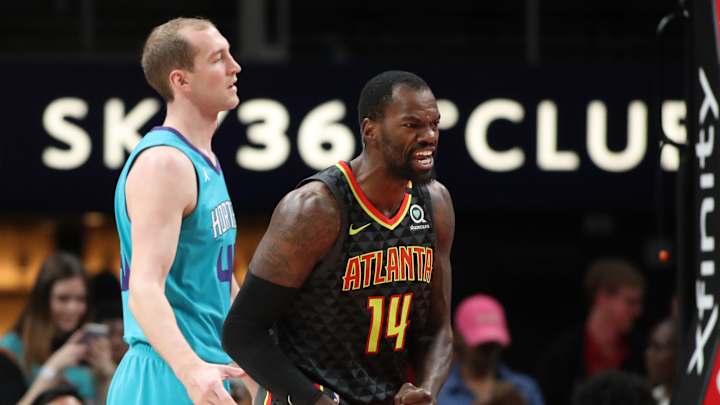2019-20 Player Review: Dewayne Dedmon

Not long after letting Dewayne Dedmon go in the summer of 2019, Travis Schlenk realized his mistake. The Hawks began the following season with the least effective center rotation in the NBA (a fact exacerbated by John Collins’ 25-game suspension and nagging injuries to Alex Len), which pulled the rug out from what could have been a promising season. So he brought Dedmon back from Sacramento at the trade deadline in an attempt to restore balance to an unsteady team.
The seven-year veteran spent the best two years of his career in Atlanta, posting 10.4 points and 7.7 rebounds per game on 37 percent 3-point shooting while starting 98 of his 126 outings in 2018 and 2019. His ability to shoot helped open up the floor for playmakers like Trae Young and John Collins, while his length and positioning at the rim gave Atlanta some semblance of defensive integrity. The ability to reliably space the floor and protect the rim is the most valuable combination of skills a non-superstar center can have in the modern NBA, and for two years, Dedmon played the part exceptionally.
As much as his production, the Hawks missed Dedmon’s presence last season. A young group like Atlanta needed his voice, which was, without exception, the team’s loudest both on the court and in the locker room. He communicates on defense, holds teammates accountable for mistakes, and keeps morale relatively high (despite mounting losses). His arrival was a breath of fresh air for the rest of the Hawks, who were noticeably less tense and more jovial with Dedmon around.
“You could see the difference the first game he came back, just having somebody yelling and screaming on defense and making sure he’s talking on the bench,” Bruno Fernando told SI. “A lot of times when we come to timeout, as soon as we sit down he’s the first guy talking. So to have a guy like that who comes in and communicates -- he’s always one to have his message heard.”
That, however, couldn’t entirely mask a disappointing year on the floor. After rounding into one of the most valuable 3-and-D centers in the NBA, Dedmon’s jumpshot abandoned him in 2020. In Sacramento, Luke Walton buried him in the rotation behind a surging Richaun Holmes and a developing Marvin Bagley III, and the few minutes Dedmon did play weren’t on par with the reputation he’d spent the last two seasons earning. He only played 10 games in Atlanta before the season was suspended, but shot just 22 percent from beyond the arc as a Hawk -- and 20.6 percent for the full season -- and therefore didn’t have quite the same gravitational pull on defenses he did the previous two years.
Still, Atlanta posted a 114.5 offensive rating in 233 minutes with Dedmon on the court, and his reputation and familiarity with the team’s system allowed him to plug in fairly seamlessly after being traded. Defensively, his impact was a testament to the value of competence at the game’s most important defensive position. The Hawks held teams to seven fewer points per 100 possessions with Dedmon on the court than with him off, largely due to massive disparities in opponents’ shooting frequency and accuracy at the rim. That’s partially a reflection of how ineffective Atlanta’s other centers were on defense, but also a credit to Dedmon’s own defensive acumen.
Dedmon dealt with soreness in his shooting elbow for much of this season, and the degree to which that affected his shooting accuracy or mechanics isn’t entirely known. At age 30, Dedmon will likely continue to gradually decline physically, which will limit his effectiveness as a rim protector and roll man. Even with positive regression to the mean, he likely won’t provide surplus value on a $13.3 million salary next year. Atlanta can live with that next season with Collins and Clint Capela filling the rest of the minutes in the frontcourt; Atlanta has plenty of excess cap space, and Dedmon’s game should support Collins and Capela well provided his shooting drifts back toward league-average.
As a starting center, Dedmon was merely passable last season as he struggled on offense. But for the backup role he’ll play next season, he is more than qualified. He may not be as central as he was the last three seasons, but he’ll help provide the Hawks with 48 minutes of capable two-way play at a critical position. That alone should raise Atlanta’s floor on both ends of the court; if Dedmon rediscovers his shooting touch, the Hawks could turn arguably the worst positional group in the NBA into one of the league’s most reliable center tandems next season.

I am a basketball writer focused on both the broad concepts and finer points of the game. I've covered college and pro basketball since 2015, and after graduating from Indiana University in 2019, joined SI as an Atlanta Hawks beat writer.
Follow @bladner_